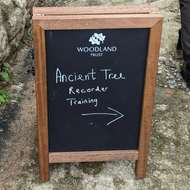Out and About - Ancient Tree Training Day
We regularly encourage our employees to get out and take part in local volunteering opportunities, and this month it was the turn of Louise and Christian. They attended a training day hosted by the Woodland Trust at a remote farm on the edge of Dartmoor.

The Woodland Trust Ancient Tree Inventory is a digital database of the oldest and most important trees in the UK, you can see it online for yourself here and it’s well worth a look. You’ll find resources that provide a fantastic introduction to the subject, and an incredible ‘Tree Search’ function which you can use to find ancient, veteran and notable trees in your area.

The UK has thousands of ancient trees, more than many other European countries. The final stage of a tree’s life can last for hundreds of years, and during this period the tree becomes hugely ecologically important. Ancient trees are full of nooks and crannies that provide homes and food sources for mammals, bats and birds. Even their falling branches hold value as decaying wood is the preferred habitat of thousands of species of invertebrates. By adding trees to the Ancient Tree Inventory, volunteers can help the Woodland Trust to identify and protect our most valuable trees.

The inventory already lists more than 160,000 trees, but there are many more out there to find. This is where volunteers like Louise and Christian come in! We’ll let Christian continue…
“The day began nice and early as we set out from Pirongs in our boots and wet weather gear to find Hall Farm. After negotiating some rather hairy lanes and a stone bridge barely wider than the car, we arrived in one piece and settled down in the cosy training room, part of a farmhouse that dates back to the 16 th century! The other trainees included Dartmoor rangers, tree surgeons and marine biologists, so we were surrounded by a wealth of experience as we spent a productive morning learning how to assess, categorise, measure, and record each tree in order to add it to the inventory.

After some lunch we headed out into the mist and rain to find some trees! We were soon glad of our boots as we traversed boggy fields, crossing a swollen stream (which Lou nearly fell into) to reach our goal. We split up into smaller groups, each focusing on a different tree. Louise and myself chose a beautiful maiden Sessile Oak and we started taking our measurements.

The tree was definitely showing some signs of age with a wide base, hollowing trunk, and dead wood in the crown, and with the help of the trainer we classed it as a veteran, with another few decades to go before it gains ancient status! We added the record to the inventory, where it can still be seen on the map to the Northwest of Harford.

We spent around three hours trekking across the estate, and in that time we saw some incredible trees, including a dead oak which was home to a hunting wasp who came out to say hello!

We finished the day by trekking across the farm to find an ancient small leaved lime ‘phoenix’. Phoenix trees are those which have fallen over or broken apart, but continue to grow upwards. This tree had various species of fungi growing around the trunk, and also featured aerial roots, descending from high up in the tree, searching for the soil below.

We both had an incredible day picking up some amazing information about the beautiful landscape in which we’re lucky enough to live, and Louise has since been on several trips to Dartmoor with office dog Monty in tow, seeking out new trees to add to the inventory.
The Woodland Trust hold regular Ancient Tree Recorder training days across the country, they’re a fantastic opportunity to get outdoors and learn more about our green spaces. You can find upcoming Woodland Trust volunteering opportunities near you on their website, both of us highly recommend giving it a go!"




















